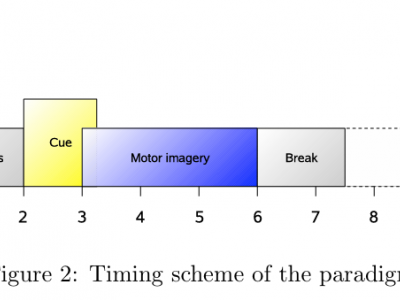Biophysiological Signals

Finger Scanning Experiments: Participants conducted experiments while seated and wearing an eye mask to eliminate visual information. They were instructed to horizontally scan the surface back-and-forth eight times with one of their fingers to assess surface roughness. The finger's motion was optically captured at a frame rate of 60 fps. Scanning speed was determined by measuring finger positions at each frame and dividing them by the frame length. Image analysis was performed using OpenCV, where the finger outline was extracted from the video.
- Categories:
 53 Views
53 ViewsIt has proved that the auscultation of respiratory sound has advantage in early respiratory diagnosis. Various methods have been raised to perform automatic respiratory sound analysis to reduce subjective diagnosis and physicians’ workload. However, these methods highly rely on the quality of respiratory sound database. In this work, we have developed the first open-access paediatric respiratory sound database, SPRSound. The database consists of 2,683 records and 9,089 respiratory sound events from 292 participants.
- Categories:
 4495 Views
4495 Views
To understand the role of myo-inositol oxygenase (miox) in the osmotic regulation of Nile tilapia, its expression was analyzed in various tissues. The results showed that the expression of miox gene was highest in the kidney, followed by the liver, and was significantly upregulated in the kidney and liver under 1 h hyperosmotic stress. The relative luminescence efficiency of the miox gene transcription starting site (-4617 bp to +312 bp) under hyperosmotic stress was measured.
- Categories:
 70 Views
70 ViewsThe Ground Reaction Forces are generated when walking, specifically when the foot contacts the ground, this information is directly related to the physical characteristics of each person, on the other hand, the growth that has the implementation of artificial intelligence algorithms for the diagnosis or evaluation of both pathologies and rehabilitation that occur in the lower limb are a very large area of opportunity.
- Categories:
 127 Views
127 ViewsElectromyography is useful for those interested in the study of biological signals and their processing, identifying the characteristics of these signals is valuable for the design of prosthetic and robotic systems or in rehabilitation for patients with pathologies of the lower limb. In this case, in particular, the EMG signals of the biceps femoris generated during the gait cycle are intended to characterize the muscle activation signals during walking. For the development of this database, one hundred users were invited to participate.
- Categories:
 111 Views
111 ViewsThis data set consists of EEG data from 9 subjects. The cue-based BCI paradigm consisted of four di erent motor imagery tasks, namely the imag ination of movement of the left hand (class 1), right hand (class 2), both feet (class 3), and tongue (class 4). Two sessions on di erent days were recorded for each subject. Each session is comprised of 6 runs separated by short breaks. One run consists of 48 trials (12 for each of the four possible classes), yielding a total of 288 trials per session.
- Categories:
 350 Views
350 Views
This dataset is developed to support research on early warning of pilots' cognitive collapse. It encompasses the recordings of 10 participants over 3 separate sessions in the simulated flight experiment paradigm. The experiment aims to elicit the pilots' cognitive collapse state and to early warn of the tipping points, for details you can refer to the paper "An Early Warning Approach for Pilots’ Cognitive Tipping Points Based Multi-modal Signals". Each trial consists of 3 stages that can induce cognitive states at low, medium, and high level with a cognitive collapse.
- Categories:
 89 Views
89 Views
The dataset encompasses the recordings of 10 participants over 3 separate sessions in the simulated flight experiment paradigm. The experiment aims to elicit the pilots' cognitive collapse state and to early warn of the tipping points, for details you can refer to the paper "An Early Warning Approach for Pilots’ Cognitive Tipping Points Based Multi-modal Signals". The dataset includes EEG, eye movement, task performance data, and experimenter's recording. It has a total of 30 trials and is approximately 4.7G in size.EEG signal.
- Categories:
 47 Views
47 Views




